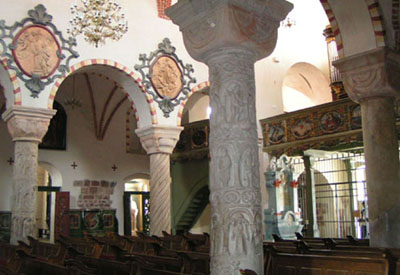
Strzelno Columns - A Detailed Description
Dr. Joanna Szczesna, Catholic University of Lublin, Poland
In
the Holy Trinity church in Strzelno, there are four columns. They are dated to
the end of the 12th century. This assessment is based on their
architectural details and on historical grounds. There
is high interest relating to the
north-eastern and southeastern pair of columns – they are unique throughout

INTERPRETATION
OF PERSONIFICATIONS ACCORDING TO ZYGMUNT ŚWIECHOWSKI:
Personification
of The Virtues on the south-eastern column:
|
Religiousness |
UNKNOWN |
Humility |
Christ’s peace |
Discipline |
Chastity |
|
Faith |
Prayer |
UNKNOWN |
UNKNOWN |
UNKNOWN |
Humility |
|
Patience |
Justice |
Justice |
UNKNOWN |
Obedience |
Abstinence |
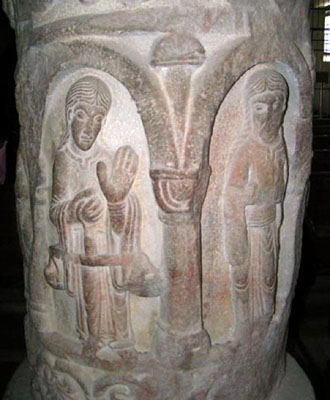
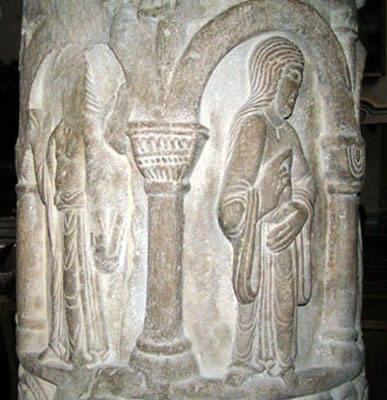
Personification
of The Vices on the north-eastern column:
|
Lust |
Envy |
Sloth |
Lust |
Lust |
Impurity |
|
Slaughter |
Wantonness |
Perjury |
Idolatry |
Gluttony |
UNKNOWN |
|
Wrath |
Pride |
Idolatry |
UNKNOWN |
UNKNOWN |
UNKNOWN |
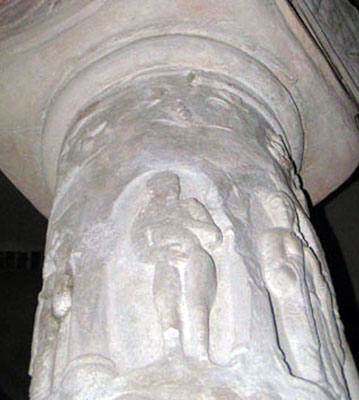
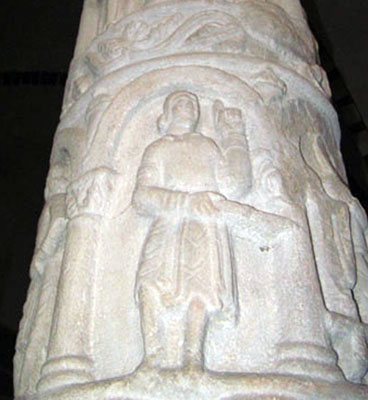
INTERPRETATION OF
PERSONIFICATIONS ACCORDING TO KRYSTYNA ROZALIA MARKOWSKA:
Personification
of The Virtues on the south-eastern column:
|
Love |
Charity |
Peace |
Chastity |
Morality |
Benevolence |
|
Obedience |
Faith |
Hope |
Joy |
Content |
Patience |
|
Patience |
Humility |
Justice |
Prudence |
Courage |
Moderation |
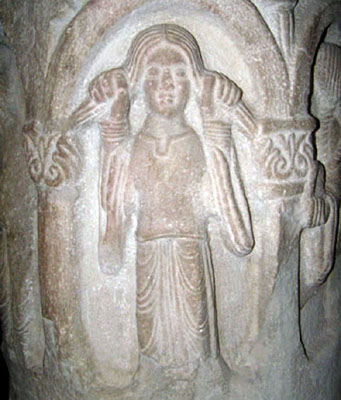
Personification
of The Vices on the north-eastern column:
|
Wantonness |
Jealousy |
Sloth |
Vanity |
Frolic |
Profligacy |
|
Deceit |
Delusion |
Perjury |
Idolatry |
Gluttony |
Greed |
|
Wrath |
Conceit |
Idolatry |
UNKNOWN |
UNKNOWN |
Impatience |
INTERPRETATION OF PERSONIFICATIONS ACCORDING TO ZBIGNIEW SROKA:
Personification
of The Virtues on the south-eastern column:
|
Obedience to the
convent |
Love - Compassion |
Modesty |
Faith |
Obedience to God |
Obedience |
|
Persistence -
Fidelity |
Prayer |
Convent |
Peacefulness
(?) |
Patience
(?) |
Renouncement –
Following Christ |
|
God service |
Prudence |
Justice |
Moderation |
Humility |
Piousnes |
Personification
of The Vices on the north-eastern column:
|
Despair |
Temptation -Envy |
Sloth |
Vanity |
Vanity |
Impurity |
|
Slaughter |
Plunder |
Revenge |
Disbelief |
Gluttony |
Egoism |
|
Wrath |
Greed |
Pride |
Deceit |
Injustice |
Lie |
The poses and
the gestures of some figures refer to the solutions discovered in Antiquity. The
personification of Impurity may be seen as one of the examples where Vice is
represented as a naked woman in a pose characteristic for the antique
representations of Venus (mostly Venus Pudica). The personification,
unanimously interpreted by the three researchers as Wrath and shown as a woman
pulling out her hair, can also have an antique origin. This was the way Mourners
were presented in Antiquity. In the
Christian context, this manner of representation can indicate the
personification of Despair (Desperatio).
The images are
considered unique due to their location – it was most common to place
personifications of Virtues and Vices on the facades of churches. Static
presentation of the figures is also characteristic of this particular imagery,
as it was most common to portray the dynamic fight between the Virtues
and the Vices.
In those
interpretations the use of the Virtues and the Vices
motives to decorate the architectonic cantilevers shows the inspiration found in
treatises which were written for the use of the nuns and very popular in
monastic circles, or even by themselves, such as Speculum Virginum which
described The Trees of Virtues and Vices; works of the Benedictine nun
Hildegard of Bingen, particularly Scivias and Ordo Virtutum and Hortus
Deliciarum of Herrad of Landsberg. The miniatures which illustrated the
works of Hildegard of Bingen could have served here as an intermediary between
the text and the sculpture imagery.
In accordance
with the symbolism of the parts of the world, personifications of the Vices
were placed on northern column, and personifications of the Virtues on
the southern one. The ideological message is confirmed by the closeness of the
altar, these personifications can be understood in the context of the liturgical
formula confiteor.